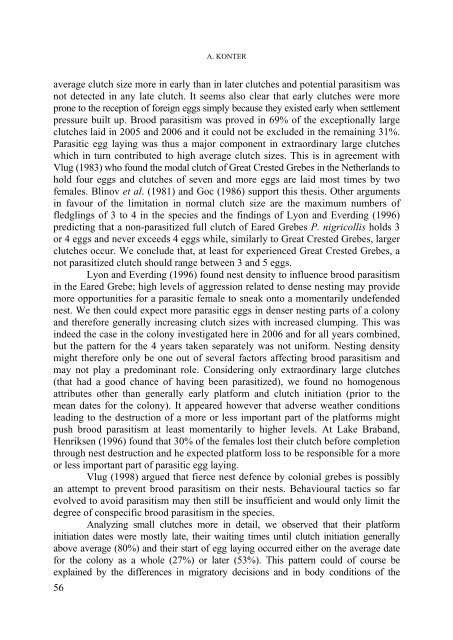biologia - Studia
biologia - Studia
biologia - Studia
Create successful ePaper yourself
Turn your PDF publications into a flip-book with our unique Google optimized e-Paper software.
A. KONTER<br />
average clutch size more in early than in later clutches and potential parasitism was<br />
not detected in any late clutch. It seems also clear that early clutches were more<br />
prone to the reception of foreign eggs simply because they existed early when settlement<br />
pressure built up. Brood parasitism was proved in 69% of the exceptionally large<br />
clutches laid in 2005 and 2006 and it could not be excluded in the remaining 31%.<br />
Parasitic egg laying was thus a major component in extraordinary large clutches<br />
which in turn contributed to high average clutch sizes. This is in agreement with<br />
Vlug (1983) who found the modal clutch of Great Crested Grebes in the Netherlands to<br />
hold four eggs and clutches of seven and more eggs are laid most times by two<br />
females. Blinov et al. (1981) and Goc (1986) support this thesis. Other arguments<br />
in favour of the limitation in normal clutch size are the maximum numbers of<br />
fledglings of 3 to 4 in the species and the findings of Lyon and Everding (1996)<br />
predicting that a non-parasitized full clutch of Eared Grebes P. nigricollis holds 3<br />
or 4 eggs and never exceeds 4 eggs while, similarly to Great Crested Grebes, larger<br />
clutches occur. We conclude that, at least for experienced Great Crested Grebes, a<br />
not parasitized clutch should range between 3 and 5 eggs.<br />
Lyon and Everding (1996) found nest density to influence brood parasitism<br />
in the Eared Grebe; high levels of aggression related to dense nesting may provide<br />
more opportunities for a parasitic female to sneak onto a momentarily undefended<br />
nest. We then could expect more parasitic eggs in denser nesting parts of a colony<br />
and therefore generally increasing clutch sizes with increased clumping. This was<br />
indeed the case in the colony investigated here in 2006 and for all years combined,<br />
but the pattern for the 4 years taken separately was not uniform. Nesting density<br />
might therefore only be one out of several factors affecting brood parasitism and<br />
may not play a predominant role. Considering only extraordinary large clutches<br />
(that had a good chance of having been parasitized), we found no homogenous<br />
attributes other than generally early platform and clutch initiation (prior to the<br />
mean dates for the colony). It appeared however that adverse weather conditions<br />
leading to the destruction of a more or less important part of the platforms might<br />
push brood parasitism at least momentarily to higher levels. At Lake Braband,<br />
Henriksen (1996) found that 30% of the females lost their clutch before completion<br />
through nest destruction and he expected platform loss to be responsible for a more<br />
or less important part of parasitic egg laying.<br />
Vlug (1998) argued that fierce nest defence by colonial grebes is possibly<br />
an attempt to prevent brood parasitism on their nests. Behavioural tactics so far<br />
evolved to avoid parasitism may then still be insufficient and would only limit the<br />
degree of conspecific brood parasitism in the species.<br />
Analyzing small clutches more in detail, we observed that their platform<br />
initiation dates were mostly late, their waiting times until clutch initiation generally<br />
above average (80%) and their start of egg laying occurred either on the average date<br />
for the colony as a whole (27%) or later (53%). This pattern could of course be<br />
explained by the differences in migratory decisions and in body conditions of the<br />
56
















